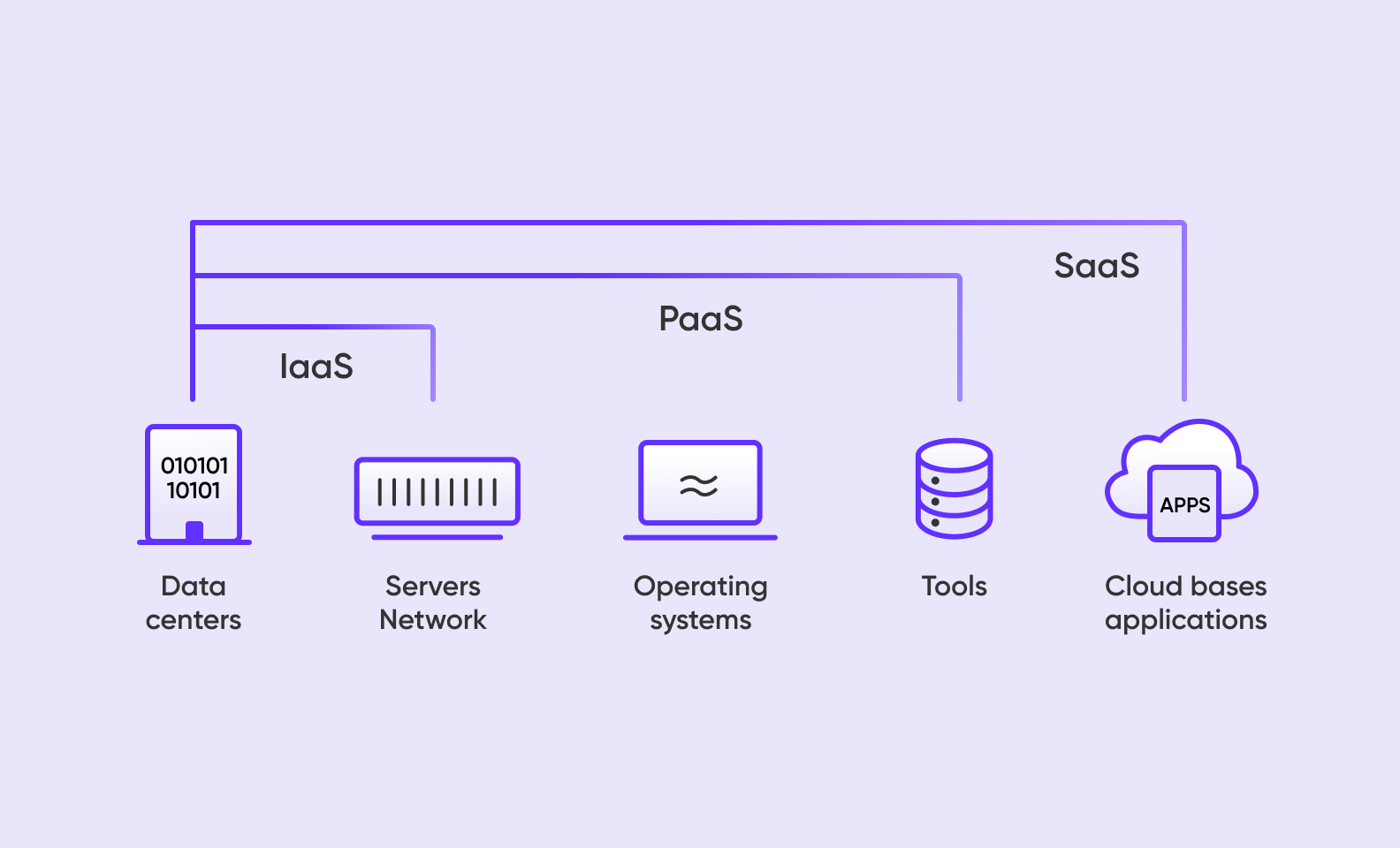The Software-as-a-Service (SaaS) landscape is booming, with businesses increasingly opting for on-demand, scalable solutions over traditional software ownership. But building a robust and reliable SaaS offering demands a solid foundation: modern cloud infrastructure.
This blog unveils the key strategies and considerations for effectively developing SaaS solutions on cloud platforms. Buckle up, and let’s embark on a journey to the cloud!
Why Embrace the Cloud for SaaS Development?
The cloud offers numerous advantages for SaaS development:
- Agility and Scalability: Easily respond to user growth and fluctuating demands by dynamically scaling resources up or down. No more hardware headaches!
- Cost-Effectiveness: Pay-as-you-go pricing models eliminate upfront infrastructure investments, allowing you to focus on development and growth.
- Global Reach: Deliver your SaaS offering to a worldwide audience with geographically distributed cloud infrastructure.
- Enhanced Security: Leverage the robust security features and expertise of cloud providers to protect user data and applications.
- Streamlined Development: Focus on your core competencies, as cloud providers handle infrastructure management and maintenance.
Choosing the Right Cloud Platform: A Landscape Overview
Selecting the ideal cloud platform is crucial. Here are the major players and their strengths:
- Amazon Web Services (AWS): The industry leader, offering a vast array of services and integrations. Ideal for large enterprises.
- Microsoft Azure: Strong focus on enterprise security and integration with Microsoft products.
- Google Cloud Platform (GCP): Known for its innovative open-source technologies and competitive pricing.
- DigitalOcean: Simpler, developer-friendly platform suitable for smaller projects.
Consider factors like cost, security features, desired integrations, and your team’s expertise when making your choice.

Building Blocks for a Stellar SaaS on the Cloud:
- Microservices Architecture: Break down your application into independent, deployable services for enhanced scalability, resilience, and easier development.
- Containerization: Package your application code and dependencies in containers like Docker for consistent and portable deployments across diverse cloud environments.
- DevOps and CI/CD: Implement a continuous integration and continuous delivery (CI/CD) pipeline to automate testing, deployment, and updates, ensuring agility and efficiency.
- Serverless Functions: Leverage serverless technologies like AWS Lambda or Azure Functions to handle event-driven tasks without managing servers, simplifying your infrastructure.
- Database Selection: Choose a cloud-native database that aligns with your needs, like Amazon DynamoDB for NoSQL applications or Google Cloud SQL for MySQL and PostgreSQL.
- API Design: Define a well-structured and secure API that facilitates seamless integration with other services and future expansions.
- Security and Compliance: Implement robust security measures like encryption, access controls, and regular vulnerability scanning to protect user data and adhere to industry regulations.
- Monitoring and Observability: Monitor your application’s performance, resource usage, and user behavior to identify and address issues proactively.
Microservices Architecture for Scalability and Agility
A microservices architecture breaks down an application into small, independent services that communicate via APIs. This approach offers key advantages for SaaS solutions:
- Scalability: Individual services can scale up/down based on demand.
- Resilience: Issues with one service don’t impact others.
- Agility: Faster updates by modifying single services.
- Organization: Logical grouping of related functionality.
When designing microservices, each should have a single responsibility and small codebase. Popular frameworks like Spring Boot (Java) and Express (Node.js) facilitate microservices development.
Containerization Enables Portability Across Cloud Environments
Containers package an application’s code, libraries, dependencies, and configurations into a standardized unit. This allows the application to run consistently and reliably across any infrastructure.
Docker is the de facto standard containerization technology. Using Docker images streamlines deploying containerized applications to diverse cloud platforms like AWS, Azure, and GCP.
Key containerization benefits:
- Portability: Containers run on any cloud infrastructure.
- Consistency: Identical environments locally and in production.
- Efficiency: Containers share host OS resources for high density.
- Agility: Rapidly build, ship and scale applications.
DevOps and CI/CD Pipelines Drive Efficiency
DevOps culture emphasizes collaboration between developers and operations teams to ship software faster. Core practices like CI/CD pipelines automate application testing and deployment.
With CI/CD, code changes trigger automated builds, tests, and deployments. This ensures rapid updates without compromising quality or stability.
CI/CD benefits:
- Agility: Ship faster with automated pipelines.
- Quality: Rigorously test each code change.
- Efficiency: Reduce errors from manual processes.
- Visibility: Monitor deployments and issues.
Tools like Jenkins, CircleCI, TravisCI, and GitHub Actions facilitate implementing CI/CD.
Go Serverless to Focus on Business Logic
Serverless computing allows running event-triggered code without managing underlying servers. Platforms like AWS Lambda and Azure Functions handle resource provisioning, scaling, patching, etc. automatically.
Serverless is ideal for:
- Automating tasks like image processing
- background processes like sending emails
- glue code to integrate services
Benefits include high scalability, pay-per-use pricing, and more focus on core product development rather than infrastructure management.
Database Selection Impacts Performance and Scalability
Choosing the right database for your SaaS application is crucial. Evaluate options like:
- Relational Databases: Great for structured data and complex queries. Examples: MySQL, PostgreSQL, SQL Server.
- NoSQL Databases: Optimized for unstructured data like documents and key-value pairs. Examples: MongoDB, DynamoDB, Cassandra.
- Data Warehouses: Enable complex analytics over vast datasets. Example: Amazon Redshift, Google BigQuery.
- Search Engines: Provide real-time search capabilities. Example: Elasticsearch, Amazon CloudSearch.
Consider scalability, consistency, structure, relationships and analytics needs when selecting a database.
Well-Designed APIs Connect Services and Enable Growth
An API (Application Programming Interface) allows different software components to communicate with each other by calling features and exchanging data.
SaaS solutions should have well-documented APIs enabling:
- Integration with other cloud services like payments, analytics, etc.
- Support for mobile apps and other front-end access channels.
- Extensibility to support future growth and requirements.
Great API design principles:
- Intuitive structure using logical resource groupings.
- RESTful design for simplicity.
- Well-documented endpoints, parameters, inputs and outputs
- Versioning to support evolution without breaking changes.
- Built-in security like OAuth 2.0 authentication.
Security and Compliance Guard User Data
With SaaS applications storing customer data, security and compliance is critical. Essential practices:
- Data encryption (SSL, AES 256) to prevent unauthorized access.
- Access controls to restrict permissions.
- Input sanitization against code injection attacks.
- CI/CD security checks and vulnerability testing.
- Adherence to regulations like HIPAA, GDPR based on your industry.
Additionally, leverage security capabilities offered by cloud providers like AWS Identity and Access Management (IAM), Azure Role-Based Access Control (RBAC) and Google Cloud IAM.
Monitoring and Observability Optimize Performance
Monitoring tools provide visibility into resource utilization, application performance issues, failures, user behavior and more in cloud environments. Examples include:
- Infrastructure Monitoring: CloudWatch (AWS), Azure Monitor
- Logging: CloudWatch Logs, ELK stack, Splunk
- APM: New Relic, Datadog
- User Analytics: Google Analytics, Mixpanel
Monitoring enables identifying and troubleshooting problems proactively before customers are impacted.
Beyond Technology: other SaaS Success Factors
While robust infrastructure and development practices are essential, additional factors determine SaaS success:
- Market Validation: Ensure your offering solves real pains for target customers.
- Pricing Models: Pick sustainable pricing aligned to perceived value.
- UX Design: Create an exceptional and intuitive user experience.
- Go-to-Market Plan: Strategize how to acquire and retain users at scale.
- Customer Support: Provide responsive, white-glove assistance.
Conclusion: Your Sky is the Limit
Modern cloud platforms provide immense capabilities for ambitious SaaS ventures. By combining strategic technology decisions around architecture, infrastructure, and development with customer-centric product design and marketing, remarkable SaaS solutions can be built.
Remember, the journey starts with a single step – begin crafting your cloud-powered SaaS masterpiece today!
















Add Comment